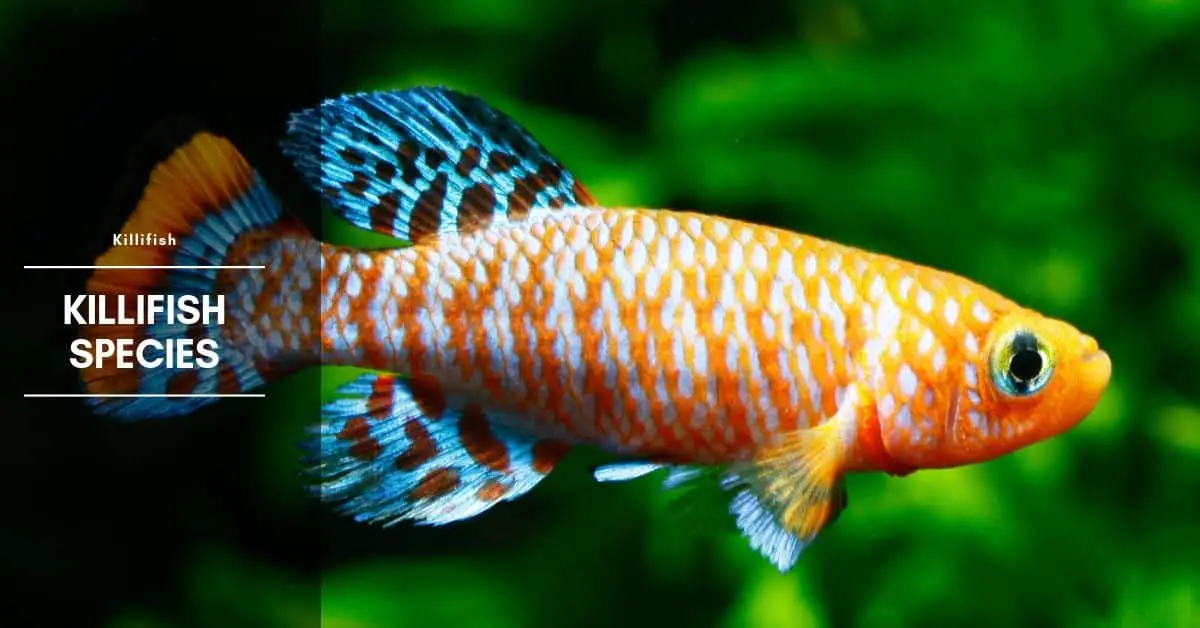These narrow-bodied, often highly colorful fish deserve to be far more popular. Their small size means that they do not need to be accommodated in a large, expensive tank.
In addition, many of the more widely available killifish are easy to maintain, and they can often be persuaded to spawn in home aquariums. Their main drawbacks are that some are highly aggressive toward their own kind, and, since they feed naturally on small invertebrates in the wild, it can be difficult to wean them onto substitute diets.
Sexing is simple since the fins of the males are more pointed than those of the females.
Why are they called killifish?
The name killifish refers to the egg-laying toothcarps, also known as cyprinodonts. Killifish include many different genera and more than 480 species. They are found in temperate to tropical regions throughout the world with the exception of Australia.
The name killifish is derived from the Old Dutch word “kil,” which means small watercourse. Many killifish live in permanent streams and brackish water zones. As adhesive spawners and plant spawners, they prefer to lay their eggs on fine-leaved plants or tangled roots.
On the other hand, some killifish live in regions with alternating dry and rainy seasons. The habitat of these killifish – usually small bodies of water dries up seasonally.
This results in the death of the adult fish, but their eggs survive the dry period buried in the muddy bottom. The young fish hatch the next time it rains, although a few offspring of the same clutch wait until the second or third rainy period.
Killifish like this that lay their eggs in the substrate (substrate spawners) and then die with the onset of the dry season are also called annual fish. The different species vary greatly in appearance. They range in size from 1 inch (2.5 cm) to over 12 inches (30 cm) long, with most species reaching a length of about 2-2 1/2 inches (5-6 cm). The males are usually more colorful than the females.
Keeping killifish in my aquarium, is it hard to keep?
Since killifish inhabit a variety of biotopes, the individual species have very different husbandry requirements.
API STRESS COAT Aquarium Water Conditioner 16-Ounce Bottle
29% OffAPI STRESS ZYME Freshwater and Saltwater Aquarium Cleaning Solution 1-Ounce Bottle
13% OffAPI ACCU-CLEAR Freshwater Aquarium Water Clarifier 4-Ounce Bottle
13% OffMost killifish prefer soft, slightly acidic water. A few species must be kept in hard alkaline water, like Lamprichthys tanganicanus from Lake Tanganyika. As a rule, killifish prefer live foods. Many species accept dry foods reluctantly if at all.
How long do killifish live?
Even under optimal aquarium conditions, many killifish do not live very long – only 1.5 years on average. Depending on the species, life expectancy varies from 12 months to 5 years. So-called annual fish like Cynolebias spp., Nothobranchius spp., and Pterolebias spp. often do not live much more than a year.
What should be the temperature in Killifish tank?
Depending on the species and natural habitat, killifish require temperatures between 68 and 86°F (20 and 30°C), a densely planted tank with places to hide, clumps of fine-leaved plants, bundles of peat fibers as a spawning substrate, and a tight-fitting cover glass because most killifish are extremely good jumpers.
Killifish in community tank
Many killifish like the Redtail Notho (Nothobranchius guentheri) or Longfin Killie (Pterolebias longipinnis) have to be kept in species aquariums because they have very special requirements.
Killifish like the Striped Panchax (Aplocheilus lineatus) can definitely be kept in a community tank but only if all the other fish in the tank are distinctly larger. Almost all killifish are predators and will regard any smaller fish as dinner.
Killifish Species
Common Lyretail – Aphyosemion australe
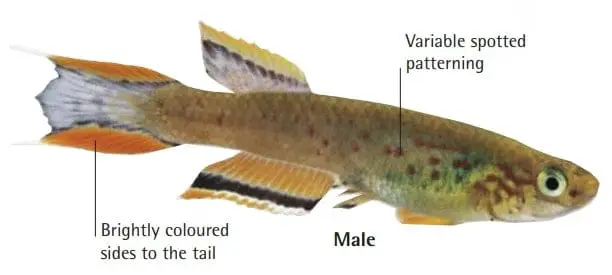
- ORIGINS West Africa, found in parts of Gabon, Cameroon, and Zaire.
- SIZE 2.5in (6 cm).
- DIET Livefoods and prepared diets.
- WATER Temperature 64–75°F (18–24°C); soft(50–100 mg/l) and acidic (pH 6.0–6.5).
- TEMPERAMENT Peaceful and social.
The color of these killifish is highly variable, but in all cases, males have more elaborate fins than females. The upper stripe on the fish’s body is more prominent than the lower, which runs along the underparts. As in other related aphyosemions, spawning is a lengthy process that takes place over the course of several days amid aquatic plants. For breeding purposes, several males should be housed with a single female. The eggs start to hatch after a period of three weeks.
Banded Killifish – Aphyosemion bitaeniatum

- ORIGINS West Africa, occurring in coastal parts of Nigeria, Benin, and Togo.
- SIZE 2 in (5 cm).
- DIET Live foods and prepared diets.
- WATER Temperature 72–75°F (22–24°C); soft(50–100 mg/l) and acidic (pH 6.0–6.5).
- TEMPERAMENT Males can be quarrelsome.
With their tall dorsal fin, the males of this species are exceptionally eye-catching. Their coloration is variable, although red may dominate, and there are usually two darker stripes down the sides of the body. Females are dull brown, with less elaborate fins. Male Banded Killifish will fight, so they should be kept apart. House a single male with two females for spawning, which usually occurs among plants.
Steel-blue killifish – Fundulopanchax gardneri
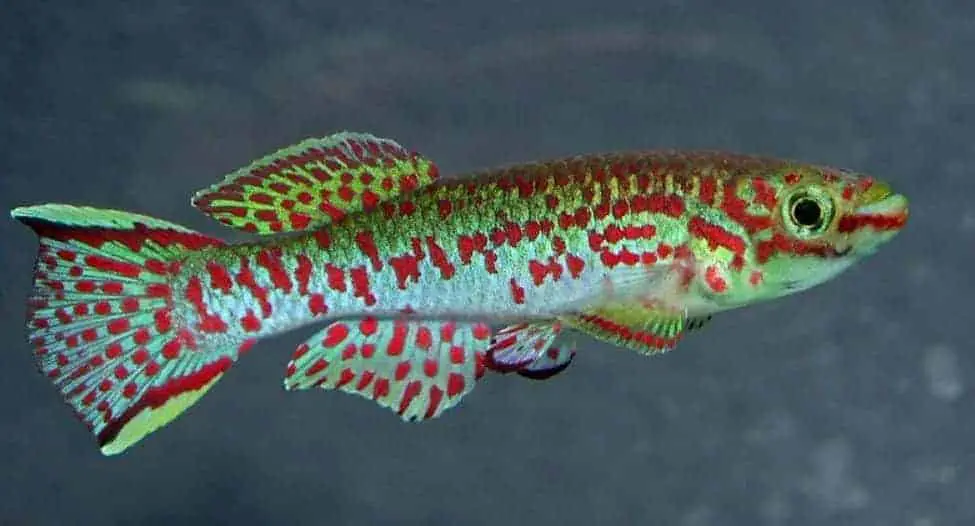
- ORIGINS West Africa, recorded in parts of Nigeria and western Cameroon.
- SIZE 3 in (7.5 cm).
- DIET Livefoods and prepared diets.
- WATER Temperature 72–79°F (22–26°C); soft (50–100 mg/l) and acidic (pH 6.0–6.5).
- TEMPERAMENT Males are quarrelsome.
Brilliant blue coloration and a variable red-spotted patterning along the body identify the male of this species, seen below. The female Clausen’s Steel Blue Killifish has brown dots on its flanks and a duller coloration on the fins. This species does not require brackish water. Spawning in the aquarium occurs on fine-leaved plants or on a spawning mop. If the tank is left full of water, the fry will hatch after two weeks.
Red-Striped Killifish – Aphyosemion striatum
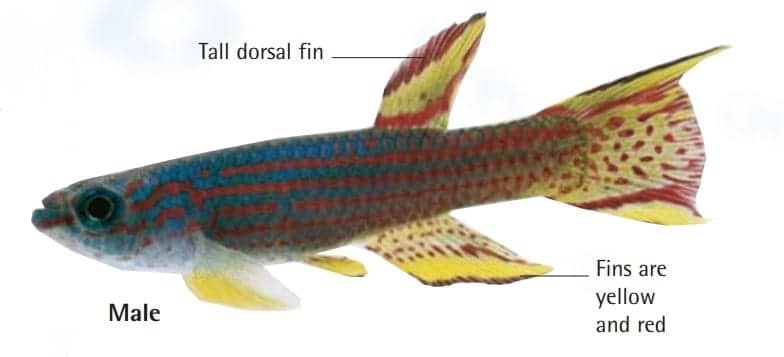
- ORIGINS Occurs in West Africa, restricted to pools and swamps in northern Gabon.
- SIZE 2 in (5 cm).
- DIET Live-foods and prepared diets.
- WATER Temperature 64–72°F (18–22°C); soft (50–100 mg/l) and acidic (pH 6.0–6.5).
- TEMPERAMENT Non-aggressive.
Bright red horizontal stripes running along the body and blue background help to distinguish male Red-Striped Killifish. Females are a dull golden-brown shade, with rounded fins. Like other killifish, they eat small live-foods, even freeze-dried items. The water should be slightly brackish, and their tank must be densely planted. It must also be kept covered since these fish can jump. Java Moss (Vesicularia dubyana) is a good spawning medium.
Two Striped Killifish – Aphyosemion bivittatum
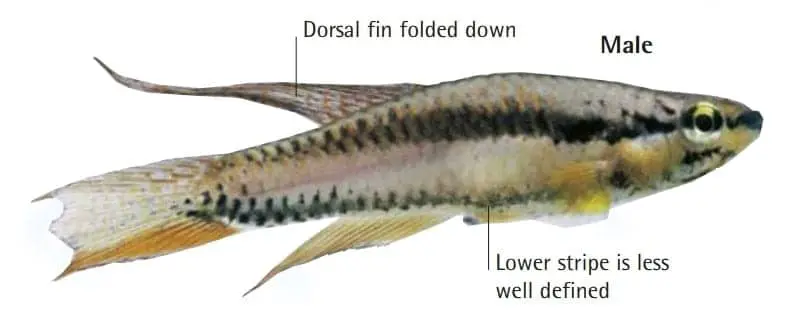
- ORIGINS West Africa, found in parts of Cameroon, Nigeria, and Togo.
- SIZE 2 in (5 cm).
- DIET Livefoods and prepared diets.
- WATER Temperature 72–75°F (22–24°C); soft (50–100 mg/l) and acidic (pH 6.0–6.5).
- TEMPERAMENT Peaceful.
The color of these killifish is highly variable, but in all cases, males have more elaborate fins than females. The upper stripe on the fish’s body is more prominent than the lower, which runs along the underparts. As in other related aphyosemions, spawning is a lengthy process that takes place over the course of several days amid aquatic plants. For breeding purposes, several males should be housed with a single female. The eggs start to hatch after a period of three weeks.
Blue Gularis Killifish – Fundulopanchax sjostedti
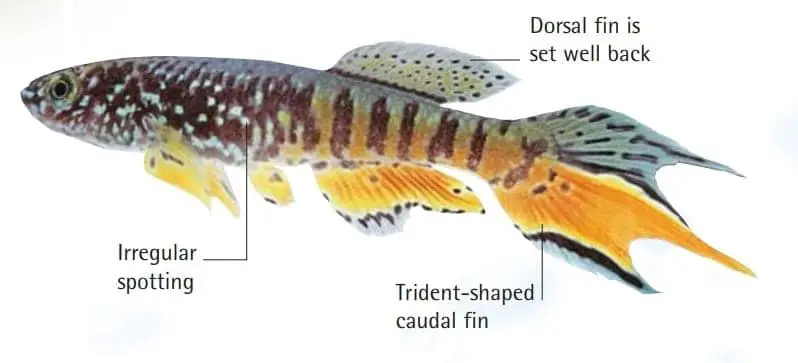
- ORIGINS West Africa, found in shallow waters in Ghana, Cameroon, and Nigeria.
- SIZE 5 in (13 cm).
- DIET Livefoods and prepared diets.
- WATER Temperature 73–79°F (23–26°C); soft (50–100 mg/l) and acidic (pH 6.0–6.5).
- TEMPERAMENT Relatively aggressive.
The color on the flanks of the Blue Gularis is variable—yellowish in some individuals, as seen below, and greenish-blue in others. Keep just one male in the company of several females, and make sure the tank has a peat base since these killifish are substrate-spawners. Remove the adults after spawning, and carefully drain the tank before removing the egg-laden peat and partially drying it. Refill the tank after laying a new peat base.
Walker’s Aphyosemion – Fundulopanchax walkeri
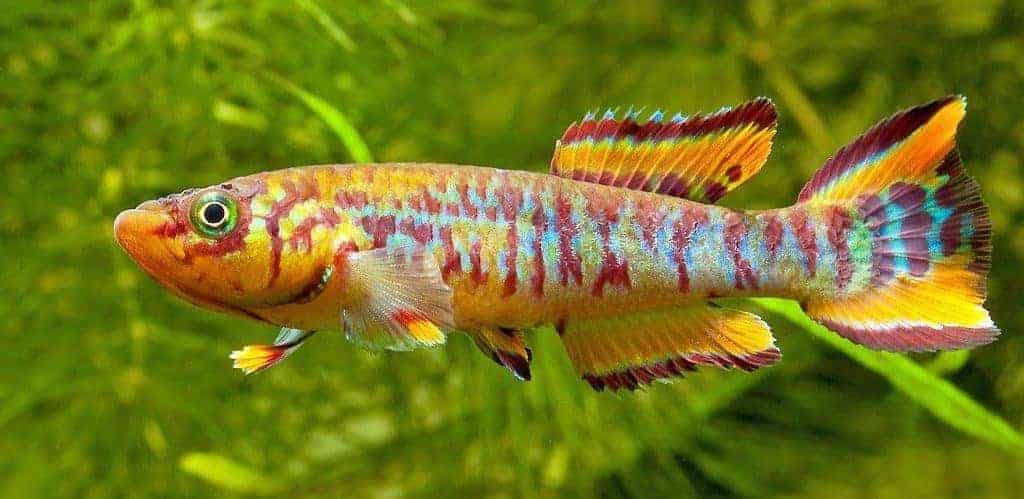
- ORIGINS West Africa, found in southern Ghana and southeastern Ivory Coast.
- SIZE 2 in (5 cm).
- DIET Livefoods and prepared diets.
- WATER Temperature 68–73°F (20–23°C); soft (50–100 mg/l) and acidic (pH 6.0–6.5).
- TEMPERAMENT Aggressive and active.
The stunning bluish coloration on the flanks, red spots on the sides of the body, and yellowish fins are the key features of these fish. They spawn either among plants or on a peat base. Peat with eggs buried in it should be removed and stored in a warm place in a plastic bag so that it partially dries but does not become powdery. After about six weeks, put the peat back into the tank. The eggs will hatch quite rapidly, and the fry can be reared on brine shrimp.
Palmqvist’s Notho – Nothobranchius palmqvisti
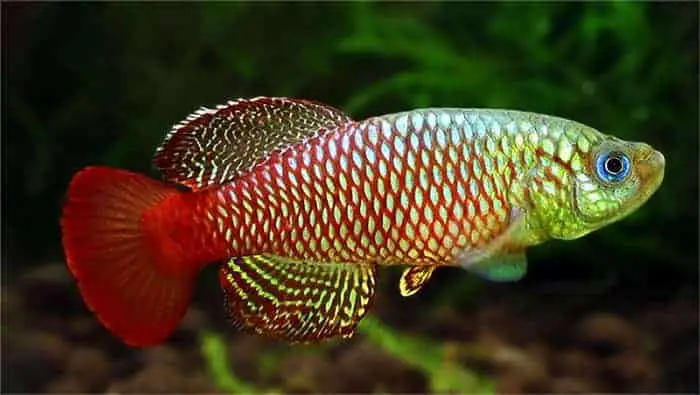
- ORIGINS East Africa, found in coastal regions of Kenya and Tanzania.
- SIZE 2 in (5 cm).
- DIET Small live foods and prepared diets.
- WATER Temperature 64–68°F (18–20°C); soft (50–100 mg/l) and acidic (pH 6.0).
- TEMPERAMENT Aggressive.
Caudal fin and a bluish body covered with a mesh-like pattern of red lines. Females are smaller and duller in color than the males, which are quarrelsome by nature. The care of these fish is straightforward, although they often do better in slightly brackish water. When breeding Palmqvist’s and other nothos, place the fish in a relatively small aquarium; it should be only about half-full of water and have a peat base. Offer the fish plenty of live-foods, and allow the water to evaporate naturally. The falling water level should trigger spawning behavior, and the female will lay her eggs in the peat substrate.
Korthaus’ Notho – Nothobranchius korthausae
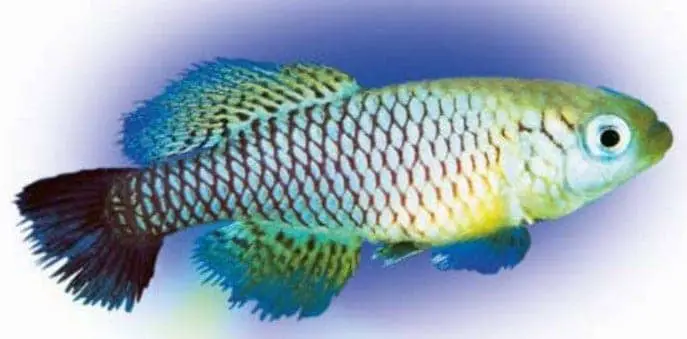
- ORIGINS East Africa, restricted to swamp areas of Mafia Island, Tanzania.
- SIZE 2.5 in (6 cm).
- DIET Small live foods and prepared diets.
- WATER Temperature 73–79°F (23–26°C); soft (50–100 mg/l) and acidic (pH 6.0).
- TEMPERAMENT Aggressive.
There are several morphs of this killifish. The example above is one of two red-tailed forms; the other has a blue body. In brown morphs, the body lines are brown rather than red, and the caudal fin is brown and yellow. Males are always brighter than females. The dependence of notho killifish on seasonal pools of water in the wild means that the water chemistry in the tank is crucial for these fish. They can live for a couple of years in aquariums.
Gunther’s Nothobranch – Nothobranchius guentheri
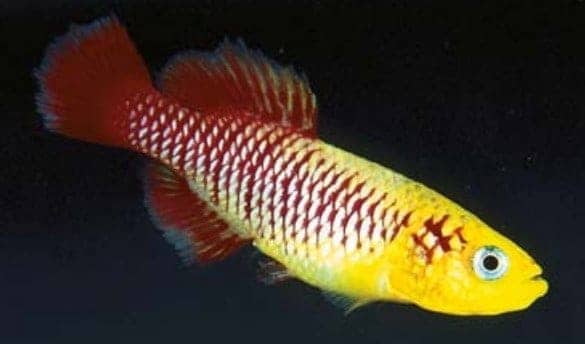
- ORIGINS East Africa, from Mombasa, Kenya, to the Pangani River in Tanzania, and on the island of Zanzibar.
- SIZE 2 in (5 cm).
- DIET Small live foods.
- WATER Temperature 73–79°F (23–26°C); soft (50–100 mg/l) and acidic (pH 6.0).
- TEMPERAMENT Aggressive.
Highly colorful, yet variable in appearance, these killifish should be kept in groups of several females and one male. They will spawn in peat but often die soon afterward. To hatch the eggs, dry the peat, rewet, and dry again before placing it in a tank. Some eggs only hatch on second contact with water; this strategy helps to protect wild populations from being wiped out if their pool dries up prematurely.
Banded Panchax – Epiplatys annulatus
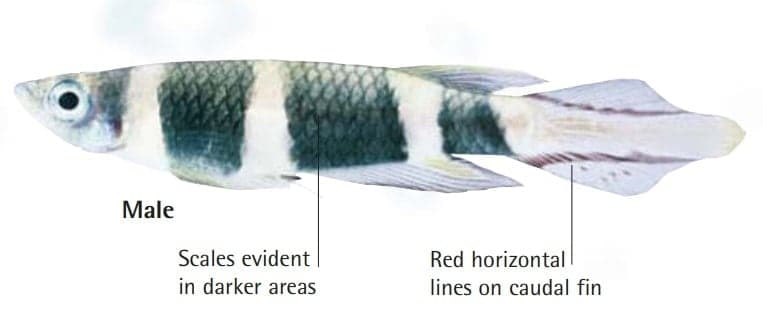
- ORIGINS West Africa, in streams in parts of Sierra Leone, Nigeria, Liberia, and Guinea.
- SIZE 1.75 in (4.5 cm).
- DIET Small live foods and prepared diets.
- WATER Temperature 73–79°F (23–26°C); soft (50–100 mg/l) and acidic (pH 6.0).
- TEMPERAMENT Relatively peaceful.
The distinctive patterning of Banded Panchax four broad, dark bands separated by paler areas—allows them to be identified with ease. Males have more colorful fins than females and also possess blue irises. Banded Panchax should be kept in a well-planted tank, under subdued lighting. They tend to swim close to the surface and will spawn among the vegetation, or on a spawning mop. These killifish will not eat their eggs, which should hatch after eight days.
Killifish Eggs Hatching
Life is a brief affair for annual killifish because the adult fish die each year when their pools dry up. However, the population itself survives, thanks to the way in which the killifish spawn on the substrate as the water level falls. Drying mud encases the eggs (shown magnified below) and protects them until the rains return, perhaps as much as two years later, filling the pools and allowing the next generation of killifish to hatch. The young fish grow rapidly, feeding largely on insects, and may reach maturity in just six weeks.

Hi, my name is Sean, and I’m the primary writer on the site. I’m blogging mostly about freshwater and saltwater aquariums, fish, invertebrates, and plants. I’m experienced in the fishkeeping hobby for many years. Over the years I have kept many tanks, and have recently begun getting more serious in wanting to become a professional aquarist. All my knowledge comes from experience and reading forums and a lot of informative sites. In pursuit of becoming a professional, I also want to inspire as many people as I can to pick up this hobby and keep the public interest growing.
Read more about Sean.
Please join also my Facebook group.

